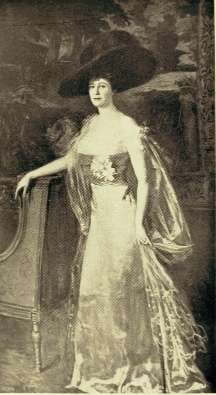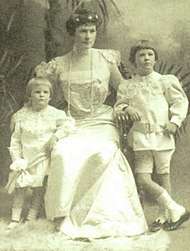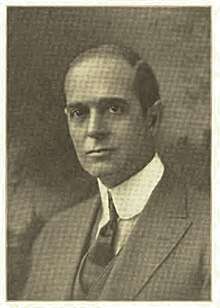Louise Sneed Hill
Louise Sneed Hill (ca. June 30, 1862 – March 28, 1955)[lower-alpha 1] was a society leader in Denver, Colorado in the 19th century. She was the wife of Crawford Hill and daughter-in-law of senator and mining executive Nathaniel P. Hill. She created the first list of socialites in Denver, called the Who's Who in Denver Society, now called the Blue Book. She entertained with lavish parties and card games for an elite group called the Sacred 36.

Early years
Louise Sneed was born in Townsville, North Carolina[1] at about the start of the American Civil War.[2] Her parents were William Morgan Sneed and Louise (Bethell) Sneed.[1] Her mother died July 11, 1862, 11 days after giving birth to Louise.[lower-alpha 1] The Sneeds had a total of six children, two males were serving in the American Civil War at the time of her death.[3] She was educated in New York City[1] at St. Mary's School on 46th Street. It was an Episcopal boarding and day school offering primary, preparatory, and collegiate education for young ladies. It also provided preparation for foreign travel.[4][5][6] Her father died December 10, 1891 near Townsville.[7] After both of her parents had died, she went to live with an older sister in Memphis, Tennessee.[2] In 1893, she came to Denver to visit cousins at Bethell mansion on Capitol Hill,[2][8] where she met Crawford Hill, the son of Senator Nathaniel P. Hill.[2]
Marriage and children
Crawford and Louise were married in Memphis in 1895.[2] Sensing that her daughter-in-law was making a power play, Alice Hale Hill said that she was "sick over Crawford's marriage".[9]

The Hills moved into an apartment at La Veta Place in downtown Denver,[9] on the present site of the City and County building.[2] They had two sons there, Nathaniel and Crawford, Jr.[2][8]
Denver society
Hill began her quest to remedy what she saw as a "social wasteland" and to become a member of Denver society, following and surpassing the footsteps of her mother-in-law.[2][8] The Hills built Crawford Hill Mansion at Tenth and Sherman Streets in 1905. Hill invited who she considered to be the best of Denver's high society to play whist or bridge. The group was made up of an elite group of 36 women for 9 tables of four people. This group became known as the Sacred 36. Margaret Brown wanted to be part of the group, but never was invited because of her improper grammar and boisterous demeanor. She labeled Hill "the snobbiest woman in Denver".[2][8] Later, when Brown became a national figure as The Unsinkable Molly Brown, following the RMS Titanic disaster, she was then let into the Hill mansion.[8]
Hill entertained in style, wearing haute-couture clothing, with the best people of Denver, the international set, and royalty. She used the best caterers and the best orchestras.[8][9] Seeking publicity, she courted the journalists and sent gifts to those that wrote about her parties.[9]
[H]er whit, charm, and high society leadership commanded attention for fifty years. Louise's stubborn intent to lift a dusty, complacent cowtown to a high level of elegance obviously struck a chord in Coloradoans. During her reign there was glamour and fun, champagne and caviar, gossip and French couture. The champagne was more bubbly then, and the orchestra didn't stop playing at midnight.
— Marilyn Griggs Riley, High Altitude Attitudes: Six Savvy Colorado Women[9]
She created the first published record of members of society in 1908 with the Who's Who in Denver Society. To be included on the list, one must have money and know how to entertain. It has evolved to the Blue Book of wealthy people from Denver.[8][9] She provided information, such as the proper hours for calling, rules for the calling card, the high tea, the wedding journey, and how to get into society.[9]
Hill traveled to New York City; Newport, Rhode Island;, and Paris. While in England, she was presented at the court of King Edward VII. She wore a satin gown embroidered with diamonds and had a red velvet cape trimmed in 14-karat gold.[8] She became the first person in Denver to entertain a president when William Howard Taft visited. He was met by a red carpet, an orchestra, and Hill's sons wearing white satin suits.[9] She was politically active, involved in Republican women's clubs.[1] Her sons married and moved to Newport, where she visited them. She continued to travel to Paris, London, and New York City.[9]
Bulkeley Wells

She met Bulkeley Wells, a polo-playing socialite, around 1914. He was a general in the Colorado National Guard and had mining interests in the state. They became involved in a love affair, which Crawford seemed to tolerate. The three of them often dined together and at times traveled together. Louise hung pictures of both men in the foyer of the mansion, Wells having the larger of the two pictures.[2] The younger Wells was married with four children. His wife, Grace Livermore Wells, divorced him in 1918.[8][9] As a result of the divorce, Wells lost $15 million in mining interests and the financing he received from his wife's family.[9]
Crawford Hill died in 1922, and Hill assumed that Wells would marry her, but he eloped with a woman from Nevada. Determined to "break him", she persuaded his remaining financial backer, Harry Payne Whitney, to withdraw his support. He lost his mining empire and gas and oil speculations. He gambled and lost the last of his money. He was on the verge of bankruptcy when he committed suicide in 1931.[2][9]
Later years
She lived in the mansion until World War II when it was difficult to get domestic servants. She sold it in 1942 and moved into a suite in the Brown Palace Hotel. She led a quiet life until her death[2] on May 28, 1955.[10][lower-alpha 1] She is buried at Fairmount Cemetery next to Crawford in the Hill family plot.[2] After her death, there was no longer an interest in the flashing entertaining performed by Hill, nor the concept of society as Hill saw it. Local historian Caroline Bancroft said "There is no Society in Denver anymore".[9]
Notes
- There is confusion about her dates of birth and death from non-reliable / genealogical sources. It appears that there is confusion between her date of birth and her husband's date of birth, but she was born about June 30 - eleven days before the death of her mother on July 11. She was not born in March of 1862. There is also some confusion about the year, she was clearly born in 1862. Her date of death is March 28, 1955, per the cited source and by reading an image of her gravestone. See citations for dates for birth and death.
References
- Leonard, John W. (1915). "Woman's who's who of America : a biographical dictionary of contemporary women of the United States and Canada, 1914-1915". New York, American Commonwealth Co. Detroit, Gale Research Co. Retrieved July 2, 2018.
- "Louise Sneed Hill and Denver's "Sacred Thirty-Six" - Fairmount Cemetery". Fairmount Cemetery. 23 April 2013. Archived from the original on 2 July 2018.
- "Mary Jeffreys Bethell, b. 1821.Diary, January 1st 1861 - Dec. 1865". docsouth.unc.edu. Retrieved July 2, 2018.
- "Louisa Sneed, 17, born in North Carolina", Tenth Census of the United States. (NARA microfilm publication T9, 1,454 rolls). Records of the Bureau of the Census, Record Group 29, Washington, D.C.: National Archives, 1880
- Nickerson's Illustrated Church Musical and School Directory of New York and Brooklyn. Nickerson & Young. 1895. p. 252.
- The Churchman. Churchman Co. 1906. p. 459.
- "Died". The Wilson Advance. December 17, 1891. p. 3. Retrieved July 2, 2018 – via Newspapers.com.
- Debra Faulkner (December 3, 2010). Ladies of the Brown: A Women's History of Denver's Most Elegant Hotel. Arcadia Publishing Incorporated. p. PT45–PT47. ISBN 978-1-61423-636-8.
- Marilyn Griggs Riley (2006). "She Decided "Who's Who in Denver Society": Louise Sneed Hill". High Altitude Attitudes: Six Savvy Colorado Women. Big Earth Publishing. pp. 7–20. ISBN 978-1-55566-375-9.
- Ellen Fisher (February 1995). "Papers of Alice Hale Hill - Collection No. 308". Denver: Western Business History Research Center, The Colorado Historical Society. Retrieved July 2, 2018.
External links
- Sneed Plantation, near Townsville / Williamsboro, North Carolina
_-_likely_taken_around_turn_of_the_century.jpg)